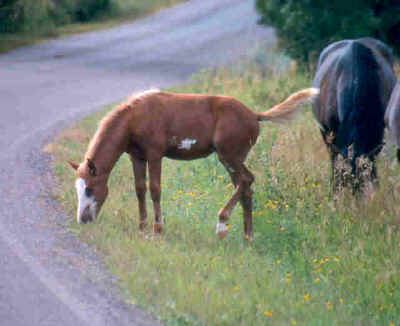Research Interests
I am broadly trained in biology and zoology and specifically trained in
wildlife ecology. My research interests lie primarily in the areas of
population ecology and behavior, especially of mammals. I have a great
interest in the prairie ecosystem and have a number of research projects on
prairie species. This is a list of some of my past and current research projects.
In the event I have interested students, some of the past projects could be
continued again..
Bison (Bison bison) Population
Ecology and Breeding Behavior

Click on picture for larger version
Bull tending a cow with her calf at
Halliday Well Prairie Dog Town in
Theodore Roosevelt National Park. |
We are studying the bison herd at Theodore
Roosevelt National Park near Medora, North Dakota. We are interested in
herd composition especially as it relates to bull:cow ratios and calf
production. In the past, park personnel have been concerned that the herd
perhaps had too many bulls. We have also been studying behavior during the
breeding season to help us determine optimal bull:cow ratios. The
information that we gather will be used by the park in making recommendations
for future bison round-ups where a portion of the herd is removed.
 sign
on my door sign
on my door |
|
Located in the Badlands, the park is home to
other large mammal species including antelope, mule deer, white-tailed deer, and
wild (feral) horses. A number of MSUM students have participated in this
study since it began in 1998. Students gain experience not only in
recording bison behavior and herd composition, but they also learn camping
skills because we camp while doing the research.

Feral foal in Theodore Roosevelt National Park.
Black-tailed Prairie Dog (Cynomys
ludovicianus) Ecology in North Dakota
While studying the bison in Theodore Roosevelt
National Park, we sometimes also incidentally study the prairie dogs.
Currently, our efforts are limited to gathering material for future DNA studies
and occasional live-trapping.

Black-tailed prairie dog in Theodore Roosevelt
National Park.
Gunnison's Prairie Dog (Cynomys gunnisoni)
Ecology in Colorado
This study ran primarily between 1991 and 1997,
but I and my research students are now analyzing different portions of the huge
data set to answer various ecological and behavioral questions. At this
time, we are looking primarily at survival in prairie dogs and also using a GIS
(Geographic Information System) to analyze spatial use in a prairie dog colony.

Donna Bruns Stockrahm gathering radiotelemetry data
from collared prairie dogs on her study site northwest of Pagosa Springs,
Colorado.
In the past, we collected DNA samples (in blood)
to look at genetic relationships of prairie dogs in the colony. In the
future, we hope to use our frozen samples to refine our techniques and further
examine prairie dog relationships.
Small Mammal Ecology in Western Minnesota
Grasslands
We have conducted considerable amounts of
live-trapping in western Minnesota to study rare small mammals. We have
concentrated our efforts on the prairie vole (Microtus ochrogaster)
which is on Minnesota's list of "Special Concern Species" and the
northern grasshopper mouse (Onychomys leucogaster) which is a
carnivorous mouse. Interestingly enough, both of these species are
monogamous in their breeding habits.

Prairie vole at Bicentennial Prairie in Clay
County, Minnesota.
On an experimental basis, we have also used radio
telemetry to monitor movements of the grasshopper mouse.

Northern grasshopper mouse from Ames Gravel
Quarry in Clay County, Minnesota.

MSUM research student Lowell Schmitz gathering
radiotelemetry data on collared northern grasshopper mice at Ames Gravel Quarry
in Clay County, Minnesota.

Donna Bruns Stockrahm and MSUM research
student Lowell Schmitz with small mammal poster.
Back to Stockrahm's home page
Tree Squirrel Ecology in Minnesota Forests
In some of the burr oak forests in Clay County,
four species of tree squirrels coexist: gray (Sciurus carolinensis), fox
(S. niger), red (Tamiasciurus hudsonicus), and northern flying
squirrels (Glaucomys sabrinus). In the past
we have conducted live-trapping studies to investigate how the species partition
the habitat allowing coexistence

MSUM research student Jacquie Gerads
live-trapping tree squirrels in Clay County, Minnesota.
Burrowing Owl (Athene cunicularia)
Ecology
Several years ago, we conducted a survey of
Billings County, North Dakota, to assess how many burrowing owls existed on the
black-tailed prairie dog colonies which is one of their prime habitats. We also
collected data on the characteristics of the burrows that they preferred to
inhabit. We found that numbers have declined drastically in recent
years for this often diurnal bird of prey.
Turtle Ecology and Behavior
This is a new study which will begin in the
spring of 2001. Female painted turtles ( Chrysemys picta)
will be fitted with radio transmitters and movements and nesting locations will
be monitored. Data will be collected on characteristics of the nesting
sites and also on the level and kind of human use of the nesting areas.

Female painted turtle with her attached
radiotransmitter and antenna.

MSUM research students Candy Zemlicka and
Just Haugen measuring turtles on 5 August 2001.

Variation in the color of painted turtles
taken from wetlands near Rollag, MN, on 5 August 2001.
Back to Stockrahm's home page

 sign
on my door
sign
on my door









